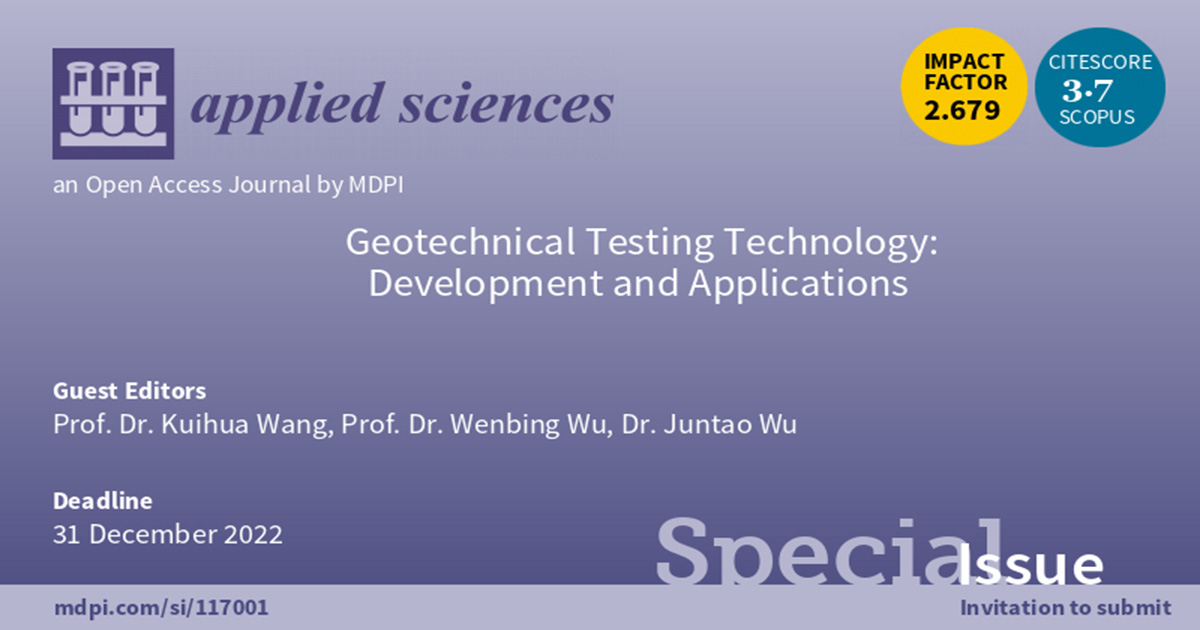Geotechnical Testing Technology: Development and Applications
A special issue of Applied Sciences (ISSN 2076-3417). This special issue belongs to the section "Earth Sciences".
Deadline for manuscript submissions: closed (31 December 2022) | Viewed by 5410

Special Issue Editors
Interests: sensors; machine learning; damage detection; defect analysis
Special Issues, Collections and Topics in MDPI journals
Interests: foundation engineering; dynamic interaction; field test; pile test; ground improvement; soil mechanics
Special Issues, Collections and Topics in MDPI journals
Interests: soil dynamics; engineering testing
Special Issues, Collections and Topics in MDPI journals
Special Issue Information
Dear Colleagues,
Considering the fact that both rock and soil are engineering media with extremely complex physical properties and that underground space structures (e.g., pile foundations, basements, subways, tunnels, pipe galleries, etc.) are always invisible, geotechnical testing technology is a significant scientific approach to evaluating the specific physical and mechanical performances of geotechnical engineering projects. It is also the basis for engineering design, construction safety, and long-term engineering monitoring. Moreover, with the ever-growing need for high-rise buildings, large foundation pits, deep-water engineering, and dredger-fill soft soil, geotechnical testing techniques are facing greater demands and are increasingly utilized to investigate ultra-large particle rockfill materials, frozen soil, gas hydrates, and other artificial geosynthetics.
In this Special Issue, we invite submissions exploring cutting-edge research and recent advances in the field of geotechnical testing technology. Both theoretical and experimental studies are welcome, as well as comprehensive reviews and survey papers.
Prof. Dr. Kuihua Wang
Prof. Dr. Wenbing Wu
Dr. Juntao Wu
Guest Editors
Manuscript Submission Information
Manuscripts should be submitted online at www.mdpi.com by registering and logging in to this website. Once you are registered, click here to go to the submission form. Manuscripts can be submitted until the deadline. All submissions that pass pre-check are peer-reviewed. Accepted papers will be published continuously in the journal (as soon as accepted) and will be listed together on the special issue website. Research articles, review articles as well as short communications are invited. For planned papers, a title and short abstract (about 250 words) can be sent to the Editorial Office for assessment.
Submitted manuscripts should not have been published previously, nor be under consideration for publication elsewhere (except conference proceedings papers). All manuscripts are thoroughly refereed through a single-blind peer-review process. A guide for authors and other relevant information for submission of manuscripts is available on the Instructions for Authors page. Applied Sciences is an international peer-reviewed open access semimonthly journal published by MDPI.
Please visit the Instructions for Authors page before submitting a manuscript. The Article Processing Charge (APC) for publication in this open access journal is 2400 CHF (Swiss Francs). Submitted papers should be well formatted and use good English. Authors may use MDPI's English editing service prior to publication or during author revisions.
Benefits of Publishing in a Special Issue
- Ease of navigation: Grouping papers by topic helps scholars navigate broad scope journals more efficiently.
- Greater discoverability: Special Issues support the reach and impact of scientific research. Articles in Special Issues are more discoverable and cited more frequently.
- Expansion of research network: Special Issues facilitate connections among authors, fostering scientific collaborations.
- External promotion: Articles in Special Issues are often promoted through the journal's social media, increasing their visibility.
- Reprint: MDPI Books provides the opportunity to republish successful Special Issues in book format, both online and in print.
Further information on MDPI's Special Issue policies can be found here.







